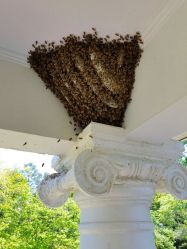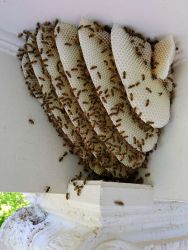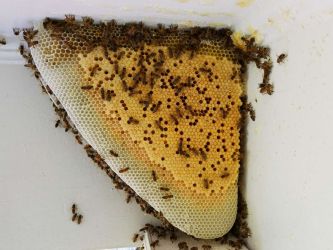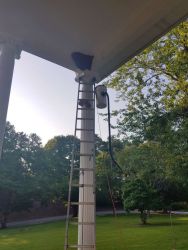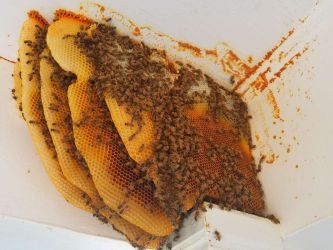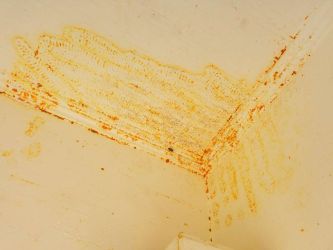Southeast Bee Removal has been removing all kinds of bee hives and bee nests from Sandy Springs since 2013. We remove honey bee swarms, established honey bee colonies, hornet nests, and yellow jacket nests. We do not do carpenter bee removal or wasp removal but can recommend other companies for these types of bees.
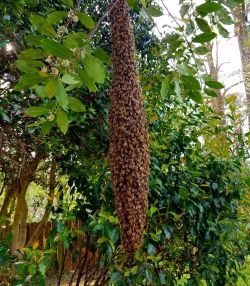 This is a picture of a Honey Bee Swarm Captured Near Sandy Springs, Georgia. The branch was hanging down under the weight of the 5 pound mass of bees. Many homeowners are concerned about bee swarms in their yard, especially if they have young children. Although honey bees swarms are not usually aggressive (most of the Africanized “killer bee” colonies are much further south) when left alone, it is best not to take a chance with 10,000 or more bees at face level in your backyard. We want to help keep your home safe and will do our best to provide you with fast removal.
This is a picture of a Honey Bee Swarm Captured Near Sandy Springs, Georgia. The branch was hanging down under the weight of the 5 pound mass of bees. Many homeowners are concerned about bee swarms in their yard, especially if they have young children. Although honey bees swarms are not usually aggressive (most of the Africanized “killer bee” colonies are much further south) when left alone, it is best not to take a chance with 10,000 or more bees at face level in your backyard. We want to help keep your home safe and will do our best to provide you with fast removal.
I always like posting unique stories of our bee removals because they are so fascinating to me! We did one job in Sandy Springs that was a little unusual for this area of Georgia. But let me first explain a about the life cycle of a honey bee colony in the winter and spring.
Honey bees are fairly dormant in the winter in this region of the United States. If the weather gets above 50 degrees a honey bee colony will have some activity at the entry point of their hive. You will likely be able to see a few bees flying around from a healthy colony of bees. The weather has to be at least in the 60s and 70s to see considerable activity. Also, the numbers of a honey bee colony are lowest in the dead of winter. This combined with cold temperatures is why you might not normally know if you have a honey bee problem at this time of year. I have had customers buy houses in the winter time, only to discover in the spring when the weather warmed up, that they had an active honey bee colony in the house that had been there for years. Surprise! Unfortunately, if a seller wants to hide this fact there is not a whole lot you can do. The bees are not likely to be noticed if an inspection is done on the house in winter.
As spring approaches and temperatures climb, honey bees start becoming more active. Established hives will explode in population in March and April and will begin preparing to swarm. This is when approximately half of the hive will leave with the old queen to establish a hive in another location. The old colony will produce a new queen and continue where they are at.
Normally, swarms of bees in this part of the southeast will look for an enclosed structure to build a nest. This protects the bees from the cold. However, areas further south, where winters are much warmer, states like Florida, Texas, and California will have more exposed bee hives. An exposed hive, is an established hive that has built a nest out in the open as their permanent home, with no structure covering all sides of the hive.
Honey bee swarms have a relatively short time of one to three days after leaving the old hive, to decide where to make their permanent home, otherwise they will starve. If an unable to find an ideal location they will settle for the next best place they can find. This bee removal we did in Sandy Springs was an exposed hive. I usually only see a couple of hives like this per year.
This newly formed bee swarm found a drive through ing attached to a brick building. The nest was no more than a couple of weeks old, but already contained 1000s of honey bees, brood, larva, and honey. It was located about 15 feet off the ground and right next to the front door. It was in a very noticeable place, and posed a problem for anyone allergic to bee stings or afraid of bees!
First infestation of honey bees under awning in Sandy Springs.
Southeast Bee Removal was able to safely and quickly remove this honey bee colony for relocation. We removed the bees, comb, wax, and honey. A handful of field bees hung around for several days and then no more bees, at least for this year. When removing bees from outside a structure, we do not guarantee against re-infestation. The reason for this, is we have no way to seal or close off the area. We do guarantee against re-infestation to the exact same location if the honey bees make a nest on the inside of your home or business. But not on the outside. So after a year or two, I was called back out, only to find a brand new honey bee colony had built a nest in the exact same location. Honey bees have an excellent sense of smell. They will very easily find and take up residence in abandoned or removed hives if they can. One good thing about the removal is that it was not a difficult one. So although the bees came back, it was easy to take care of the problem a second time.
Second infestation of honey bees under awning in Sandy Springs.
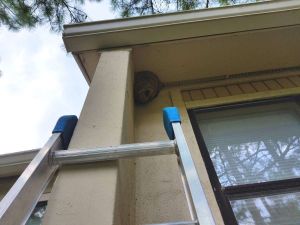 If you see honey bees in Sandy Springs, please don't call a bee exterminator. Honey bees are very important for pollination purposes. We need them! Southeast Bee Removal saves and rescues honey bees.
If you see honey bees in Sandy Springs, please don't call a bee exterminator. Honey bees are very important for pollination purposes. We need them! Southeast Bee Removal saves and rescues honey bees.
We also provide other bee hive removal. Hornets and yellow jacket nests are removed and disposed of. For these types of removals, we get rid of the entire nest. Call us, and we will do our best to provide you with outstanding service!
This hornet nest removal in Sandy Springs was located about 30 feet off the ground on the back of an apartment.

